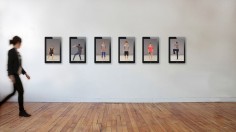Hyperchoreography
An interactive installation between dance
source: hkfringeclub
Hyperchoreography is a six-screen interactive video installation. You can activate and control the video of the six dancers in the work with your own body movements. You can become a dancer or even a choreographer of the work, experiencing the limitless joy of dancing and dance-making. Hyperchoreography is an exciting and thought-provoking experience that gives you an insight into the art of choreography and screendance.
Hyperchoreography is a new installation conceived by screendance artists Simon Fildes and Katrina McPherson from the award-winning Scottish independent production company Goat. The art-work has been created in collaboration with the internationally acclaimed Tibetan choreographer Sang Jijia, the veteran music producer Dickson Dee, six outstanding dancers and local creative, LazyAnt.
.
.
.
.
.
.
.
source: scmp
When Simon Fildes and Katrina McPherson, of the Scottish production company Goat Media, collaborated with choreographer Sang Jijia in 2010, it was a kind of blind date set up by Hong Kong’s City Contemporary Dance Company and Glasgow’s Dance House.
Although they barely knew each other, they spent five days working together in a village hall in the highlands of Scotland.
What was supposed to be a research project turned into There Is a Place, a short dance film that was so well received at its international screenings that its creators decided to team up once again.
The shooting of the new work took place in July 2013 at the HKICC Lee Shau Kee School of Creativity, with six local freelance dancers.
Post-production was carried out in collaboration with composer Dickson Dee, a long-term artistic partner of Sang, and Christopher Lee and William Wong of the newly established organisation LazyAnt, which specialises in interactive experience design and production services.
The resulting piece, titled Hyperchoreography, is an interactive digital installation inspired by the concept of hypertext, where the sequence in a work can be altered by user interaction with its collection of hyperlinked moving images. It will be presented at the sixth edition of the Jumping Frames International Dance Video Festival.
With an array of motion sensors that detect the visitors’ positions and gestures, the installation shows pre-recorded videos of six solo dancers who seemingly respond in real time to the movement of the audience in front of the six screens.
” Hyperchoreography is a non-linear dance performance ‘space’ that exists in an interactive, networked medium,” says Fildes, who calls himself and McPherson “screendance artists”.
“The elements are put in place by the creators, but the shape of the work is decided by the user at the moment of interaction. We were also influenced by [choreographer] Merce Cunningham and John Cage, who used the I Ching to determine interchangeable segments of choreographies,” he adds.
Producer Raymond Wong, of City Contemporary Dance Company, says the performance represents Jumping Frames’ first attempt to encourage audience engagement outside a traditional theatre setting.
“Dance can be promoted to the community with interactive technology and, that way, people who haven’t attended screenings or performances before can get involved.”
” Hyperchoreography has drawn interest from overseas museums and performing arts centres, and we are lining up a touring exhibition after its premiere in Hong Kong,” Wong adds. “It’s also a good way to publicise Hong Kong artists.”


